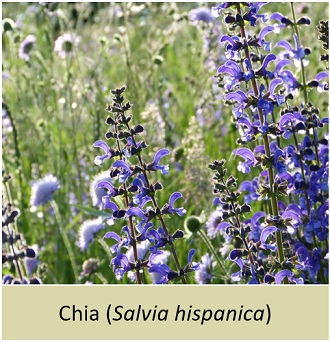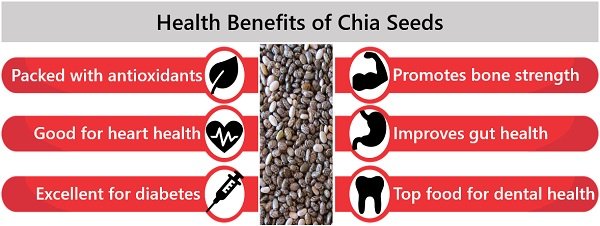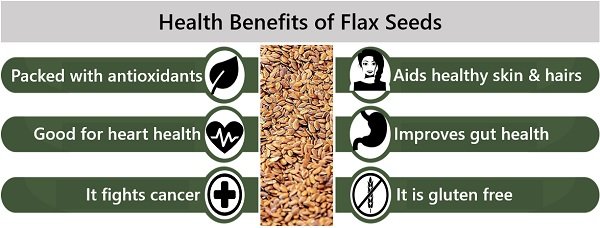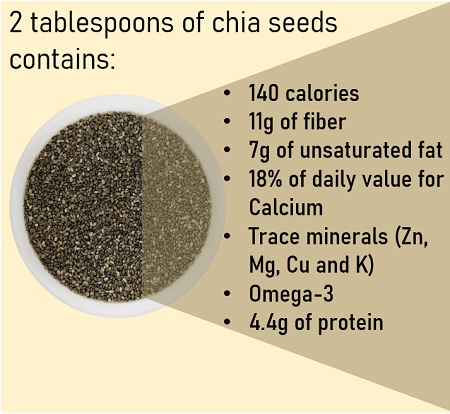Chia and flax seeds are two popular superfoods that do wonders in leading a healthy lifestyle. Both are rich in fibers and highly nutritious. These seeds contribute to improving gut health, heart health and cognitive health. So, both are fantastic additions to your diet, packed with endless health benefits.
Nowadays, most people incorporate these seeds into their diet due to their high fiber, protein and healthy fat contents. Some fitness freaks often combine both seeds in their diet to give themselves breakthrough energy.
But, before doing this, you should consult your doctor or health instructor. Despite so many similarities, there are some significant differences between the two in terms of appearance, nutrient content etc.
This post highlights the prominent differences between chia seeds and flax seeds with the comparison chart, so you can decide which is best for yourself. Also, it will give you insights into the similarities, health benefits and side effects of the two.

Content: Chia Seeds Vs Flax Seeds
Comparison Chart
| Properties | Chia Seeds | Flax Seeds |
|---|---|---|
| Alternative names | Salba seeds | Linseed or Alsi seeds |
| Botanical name | Salvia hispanica | Linum usitatissimum |
| Colour | Black, white or grey | Brown or golden |
| Size | Tiny | Bigger than chia seeds |
| Shape | Oval-shaped seeds | Teardrop-shaped seeds |
| Flavour | Neutral or bland taste | Nutty flavour |
| Origination | These originated from the Central and Southern parts of Mexico | These originated in the Middle East regions |
| Initial use | Initially chia seeds were used by the Aztec civilians for religious ceremonies, medicinal uses etc. | Initially, linen fabrics were manufactured from flax plants |
| Macronutrients | Chia seeds contain a relatively high amount of carbohydrates and fibers | Flax seeds ace when it comes to proteins and fats |
| Micronutrients | They are high in bone-strengthening minerals like calcium, phosphorus, magnesium and trace amounts of iron, selenium etc. | They have a high amount of manganese, copper and potassium |
| Lignans | They are weaker in lignans | They are rich in lignans |
| Consumption | You can consume chia seeds in different forms (like chia bran, ground or oil) | You can consume flax seeds in the form of whole seeds, ground or oil. Generally, ground flax is preferred more to reap all the nutrients and vitamins present in them |
| Rancidity | They do not go rancid due to their antioxidant makeup | They go rancid over time on exposure to heat, air or moisture |
| Shelf life | Chia seeds have a longer shelf life than flax seeds | Flax seeds have a short shelf life of 6 months |
| Sprouting | Sprouting of chia seeds generally takes 4-7 days | Sprouting of flax seeds takes 5-14 days to develop small green leaves |
What are Chia Seeds?
These are tiny, black or white, oval-shaped seeds obtained from the plant (Salvia hispanica). Chia seeds are incredibly rich in nutrients, fibers and proteins. Earlier, civilians of Aztecs and Mayan used these seeds in their diets, rituals, medicinal preparations and cosmetics. Consumption of these seeds is great for summers because they are best at keeping dehydration at bay.

Versatility: You can add them to various dishes due to their neutral taste. You can incorporate chia seeds into your diet by adding them to smoothies, puddings, and cereals. It can be used as toppings over yoghurt and salads. You can also eat them raw.
Nutrient Profile
Health Benefits
- Chia seeds are high in antioxidants (like chlorogenic acid, myricetin, quercetin etc.), preventing free-radicle damage, cancer and cellular inflammation.
- They are also high in protein, which helps you to lose weight. It will keep you full for longer, reducing your appetite and overall food intake.
- Fibers help in blood sugar management and cholesterol levels. Soluble fibers support lowering your total and LDL (bad) cholesterol in the blood.
- ALA (alpha-linolenic fatty acid) is a source of omega-3s that reduce heart disease risks.
- They also possess bone nutrients (like calcium, phosphorus and magnesium) that give you bone strength.

Side Effects
- Overeating chia seeds may cause digestive and gastrointestinal problems because they are high in proteins and fibers.
- You should ask your doctor before incorporating chia seeds into your regular diet because the effect of chia seeds on the blood sugar level is significant.
What are Flax Seeds?
These are tiny, flat, brown-golden tear-shaped seeds obtained from the plant (Linum usitatissimum). Flax seeds are rich in protein, fiber and omega-3 fatty acids. Also, these seeds incorporate some essential vitamins and minerals. These seeds are warm for your body, so their consumption is best during winters.

Versatility: Flax seeds are versatile and easy to add to yoghurt, salads, smoothies, and baked goods. You can also consume it in the form of flaxseed oil or some other supplements. Consuming ground flax seeds are recommended instead of whole because your intestine will find it easy to absorb the nutrients and fibres in them.
Nutritional Profile
Health Benefits
- Proteins in flax seeds help in weight management by keeping your tummy full and reducing your feelings of hunger and overall appetite.
- Flax seeds contain soluble and insoluble fibers. The soluble fibers slow down digestion by absorbing water and allowing your body to regulate blood sugar levels. Insoluble fibers stick to the stool, prevent constipation, and promote regular bowel movements.
- ALA in flax seeds reduces inflammation and cholesterol levels and lowers ischemic heart disease risk.
- Lignans are the antioxidants in flax seeds that decrease the growth of cancerous cells.

Side Effects
- Pregnant women should not eat ground flax seeds as still there is no research regarding how flax seeds affect pregnant women.
- The laxative property of flax seeds leads to abdominal discomfort and bowel movement.
- You must intake flax seeds with enough water; otherwise, they may obstruct the oesophagus and cause irritable bowel and abdominal pain.
Key Differences Between Chia Seeds and Flax Seeds
- Chia seeds are obtained from the Salvia hispanica plant and are available as tiny, black or white seeds. Flax seeds are obtained from the Linum usitatissimum plant and are available as brown or golden seeds.
- Chia seeds are tiny in size and appear oval-shaped. In contrast, flax seeds are bigger than chia seeds and appear teardrop-shaped.
- Both have a characteristic difference in taste or flavour. Chia seeds have a neutral or bland taste, while flax seeds have a nutty taste.
- Chia seeds are weaker in lignans, whereas flax seeds are rich in lignans that reduce blood pressure and severe symptoms of menopause.
- Sprouting of chia seeds generally takes 4-7 days under a constant temperature of 25 degrees Celsius, with adequate moisture and bright light. Oppositely, the sprouting of flax seeds takes 5-14 days to develop small green leaves under 70 degrees Fahrenheit and under indirect sunlight.
Similarities
- Both chia and flax seeds are considered superfoods that are rich in fibers and proteins.
- They both have a gelling property in reaction to water or any other liquid.
- Both prove to be good in weight management.
- You can incorporate 1-2 tablespoons of chia and flax seeds daily into your regular diet.
Conclusion
Thus, these two powerhouse seeds are packed with some serious nutritional punch. Both can be part of an overall healthy diet. But, you must be cautious about your body’s unique needs and the pros and cons of the food you add to your diet. Along with that, you should strictly follow a healthy staple diet and regular exercise to reap the benefits of these superfoods.

